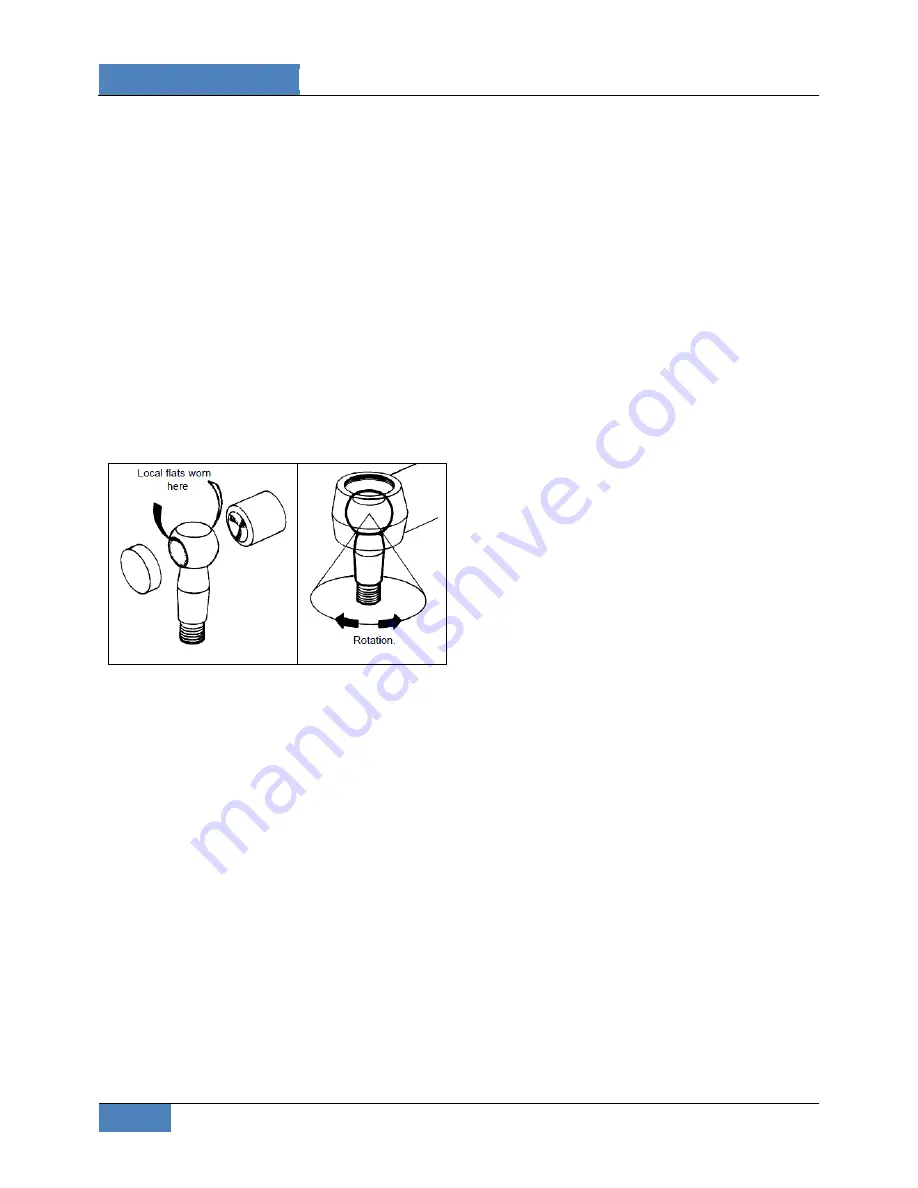
SECTION 14: STEERING
16
DOB 2490-2789 | X3-45 Commuter PA1605 Maintenance Manual (Section 14 revised April 2018)
adjuster piece fully home (SOLID) locating
thrust cup onto ball pin.
2. Still with tool located on adjuster piece, back
off carefully (LEAST AMOUNT) until adjuster
piece cotter pin is allowed to pass through
body, then remove tool.
3. Reinstall protective cap.
12.6.2
End Play Adjustment Limitation
If ball pin does not rotate when re-adjusted in
line with above instructions, this suggests that
ball pin has local worn flats as shown in FIGURE
25 (a). In this instance ball pin, thrust cup and
rubbing pad MUST be replaced, if not FAILURE
could occur in service, i.e. ball pin not being able
to move in assembly when turning from lock to
lock as shown in FIGURE 25 (b).
a
b
FIGURE 25: BALL PIN HAS LOCAL WORN FLATS
12.6.3
Dismantling Drop Type Ball Joint
1. Remove dirt seal and dirt seal pressing from
ball pin.
2. Slacken pinch bolt nut then unscrew and
remove ball socket assembly from tie rod
having first marked ball socket body and tie
rod to enable tracking on re-assembly.
3. Remove adjuster split pin from ball socket
body.
4. Remove cap then using a suitable tool i.e.: a
piece or 1”x1/8”x 9” flat bar, unscrew and
remove adjuster piece. Waggle ball pin to
free thrust cap.
5. Remove compression spring and thrust cap
from ball socket body.
6. Relieve peening on socket body top then
using a hide faced mallet, tap ball pin out of
body. This operation will also remove cover
plate from body.
7. The rubbing pad can now be removed from
body.
Thoroughly clean all parts and check for
wear, renewing where necessary.
12.6.4
Assembling Drop Type Ball Joint
1. Apply a bead of Loctite 638 sealant to
mating corner of rubbing pad in socket body
then knock rubbing pad into its recess in ball
socket body.
2. Thoroughly grease rubbing pad and ball pin
with Shell Retinax LX or equivalent.
3. Insert ball pin into body.
4. Insert thrust cap, compression spring and
adjuster piece into body.
5. Tighten adjuster piece fully home (SOLID)
locating thrust cup onto ball pin.
6. Still with tool located on adjuster piece, back
off carefully (LEAST AMOUNT) until adjuster
piece split pin is allowed to pass through
body, and that ball pin shank can be moved
by force of hand, then remove tool.
NOTE: If ball pin does not rotate when re-
adjusted in line with above instructions, this
suggests that ball pin has local worn flats. In
this instance ball pin, thrust cup and rubbing
pad MUST be replaced, if not FAILURE could
occur in service, i.e. ball pin not being able
to move in assembly when turning from lock
to lock (see FIGURE 25).
7. Fit cover plate into top of ball socket body,
re-peen using a cold chisel to secure.
8. Screw assembled ball socket onto tie rod.
Lining up marks on both
body and tie rod
previously made, or retracking using manual
instructions.
9. Fit pinch bolts and nuts then tighten nuts
alternately and progressively to 65- 75 lbf-ft
(88-102 Nm.) thus securing ball joint to tie
rod.
10. Fit dirt seal (pressing) and dirt seal (rubber)
onto ball pin.
11. Locate ball socket and tie rod assembly with
lever, carefully align and fit ball pin into hole
in tie rod arm.
NOTE: Ball pin and ball pin tapers in bottom tie
rod arms must be clean, dry and free from oil
prior to assembly.






























